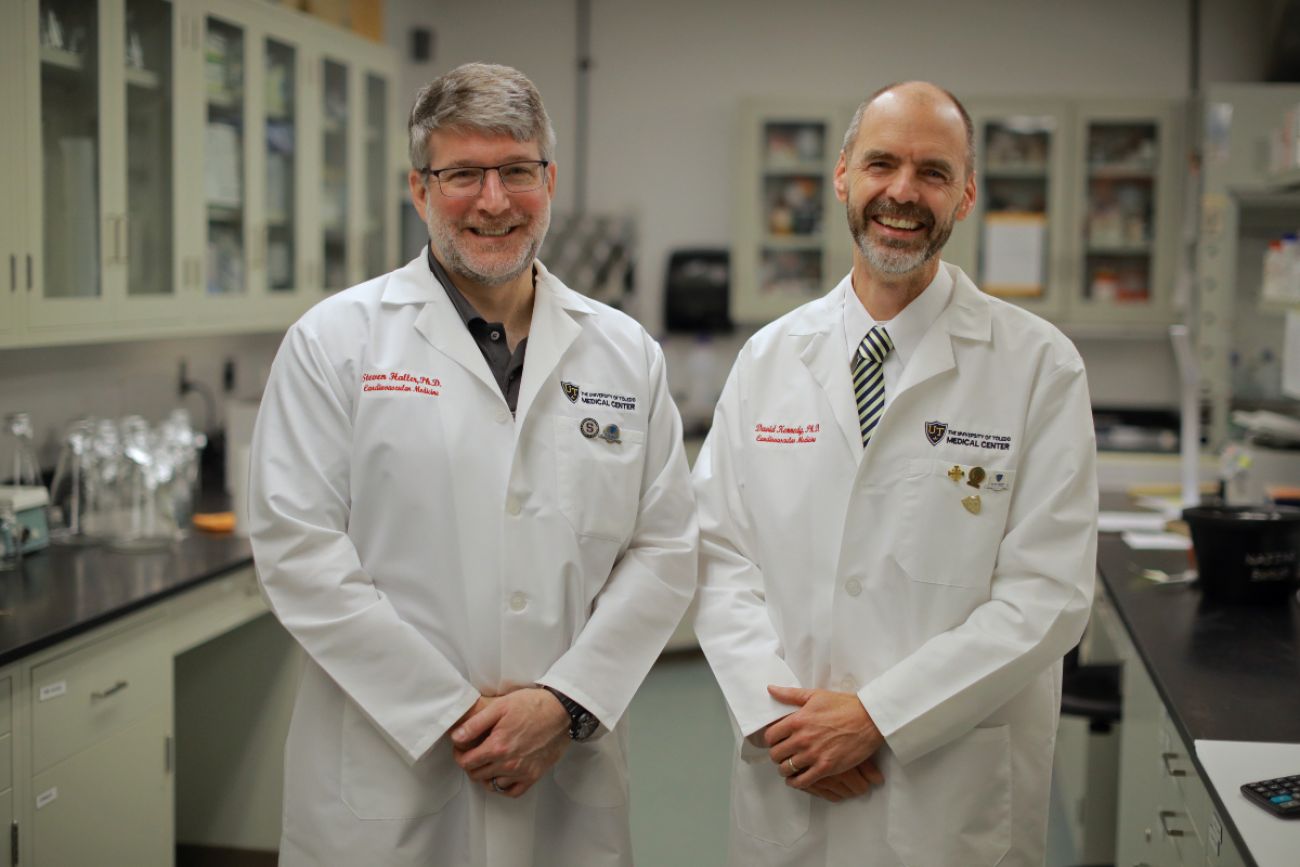Toxic Great Lakes algae makes Michigan sick. But remedy may be near

- Scientists at the University of Toledo are nearing a treatment for toxic algae exposure
- Efforts by Michigan and Ohio to reduce farming pollution that causes harmful blooms haven’t worked well
- But researchers hope a potential treatment encourages people to support reduction efforts
The toxic algae blooms that befoul Lake Erie and other regional waterways each summer are stinky, ugly and dangerous.
They’ve killed dogs, sickened boaters and triggered rashes and respiratory problems for beachgoers — and there’s little doctors can do to help.
But there’s hope that medicine will eventually be available for people who are regularly exposed to the toxin. And the treatment may be hiding in plain sight, in the same Lake Erie water that harbors the toxic threat.
Scientists at the University of Toledo have spent years searching for a way to prevent the symptoms of toxic algae bloom exposure, and they have zeroed in on a naturally occurring bacteria that’s also found in Lake Erie.
“In terms of prevention, we have a reasonably good indication (this bacteria) would work as a probiotic,” said David Kennedy, an associate professor of medicine.
Five years ago, researchers Jason Huntley and Youngwoo Seo from the University of Toledo isolated a type of bacteria in the lake that eats the most common algal toxin, microcystin. Now, that bacteria is being used to develop a preventative therapy that, when taken before exposure to algal toxins, reduces symptoms.
RELATED:
- Michigan farm czar: Our fight against Lake Erie pollution isn't working
- Report: MI and OH must spend hundreds of millions more annually to curb toxic blooms in Lake Erie
- Too few farmers are curbing pollution in Lake Erie. Should they be forced?
Kennedy and co-researcher Steven Haller said their research will fill a knowledge gap about the diagnosis, prevention and treatment of algal toxin exposure.
“Obviously, it’s a regional problem that we’re aware of and we live with,” said Kennedy. “But it also has global implications because (harmful algal blooms) are in every state, in every country. And there’s not a whole lot known about them.”
What makes algal blooms harmful
Harmful algae are an increasingly common sight in Great Lakes waterways.
They feed off excess minerals, primarily phosphorus, and thrive in warm, shallow water, which is exactly what Lake Erie provides.

Under the right conditions, they can produce toxins called microcystin that often sicken humans and kill pets. It’s not safe to touch, ingest or breathe droplets of the algae-tainted water.
Lake Erie, where hundreds of square miles of water becomes covered in a putrid green bloom every year, is the country’s most visible example of the risk. But the blooms have also been reported in Lake Superior, Saginaw Bay, Lake St. Clair near Detroit, Lake Macatawa in Holland and Lake Allegan on the Kalamazoo River, to name just a few.
It’s a nationwide threat that may be growing more widespread by the year.
In 2021, harmful algae exposure sickened at least 117 people and 2,715 animals nationwide, according to the Center for Disease Control and Prevention.
A possible treatment from nature
For now, there’s no treatment for algae exposure. But Kennedy and Haller are taking the first steps to developing one.
The potential treatment, a group of microcystin-degrading bacteria from Lake Erie, may act as a probiotic that detoxifies microcystin and strengthens the body’s response to the algal toxin, lessening symptoms.
“The bacteria, just like the bacteria in yogurt, is not toxic, and it actually has a lot of beneficial effects,” said Kennedy.
Kennedy and Haller tested the bacteria on human liver cells that had been exposed to microcystin. The main symptom of microcystin exposure, inflammation, was reduced in cells that had been pre-treated with the bacteria.
Testing on mice that drank the probiotic in their water produced the same results.
But don’t expect to be popping anti-algae pills anytime soon.
Kennedy said the probiotic needs to be tested in human clinical trials before it can be approved as a treatment.
But trials likely won’t start for three to five years, he said, because they’re expensive and require funding.
A plea for preventative measures
The possible treatment of algal toxin exposure is promising, given that efforts to reduce the farm pollution that causes algae blooms are failing.
Federal researchers expect this summer’s bloom in Western Lake Erie to be moderate to large, similar to or possibly even worse than blooms from the last few years.
Oceanographer Richard Stumpf, who helps forecast blooms for the National Centers for Coastal Ocean Science, said because of the heavy rains we got this spring, there’s a lot more phosphorus running into the lake. And the more phosphorus there is in the lake, the more likely we are to have cyanobacteria.
A 2023 report found that Michigan and Ohio are failing to meet phosphorus reduction goals they set in 2015. Fixing the problem would require the two states to spend hundreds of millions of dollars more each year.
Tom Zimnicki, agriculture and restoration policy director at Alliance for the Great Lakes, said instead, the communities affected by harmful algal blooms must bear the cost of farm pollution.
On top of direct health risks, in 2014, cyanobacteria levels in Lake Erie got so bad that The City of Toledo shut down its water system to stop contaminants from getting into its drinking water. Its residents went without drinking water for three days.
“We are running the risk of just getting to this point of acceptance, which I think is a really dangerous place,” Zimnicki said.
Kennedy and Haller said they hope their research not only leads to a treatment for algal toxin exposure, but also raises awareness about the dangers of algae blooms.
“If people just think it’s a cosmetic issue, like the water is just green, then there may not be as much interest in getting it cleaned up,” said Kennedy.
Editor's note: This story was updated on May 20, 2024 to clarify the description of the potential treatment for algae exposure.
Michigan Environment Watch
Michigan Environment Watch examines how public policy, industry, and other factors interact with the state’s trove of natural resources.
- See full coverage
- Subscribe
- Share tips and questions with Bridge environment reporter Kelly House
Michigan Environment Watch is made possible by generous financial support from:
Our generous Environment Watch underwriters encourage Bridge Michigan readers to also support civic journalism by becoming Bridge members. Please consider joining today.
See what new members are saying about why they donated to Bridge Michigan:
- “In order for this information to be accurate and unbiased it must be underwritten by its readers, not by special interests.” - Larry S.
- “Not many other media sources report on the topics Bridge does.” - Susan B.
- “Your journalism is outstanding and rare these days.” - Mark S.
If you want to ensure the future of nonpartisan, nonprofit Michigan journalism, please become a member today. You, too, will be asked why you donated and maybe we'll feature your quote next time!






